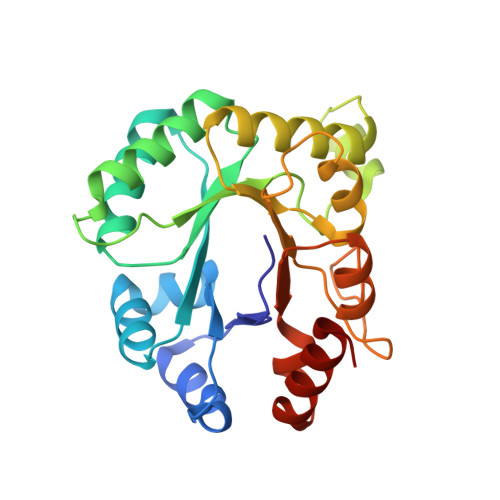The crystal structure and mechanism of orotidine 5'-monophosphate decarboxylase.
Appleby, T.C., Kinsland, C., Begley, T.P., Ealick, S.E.(2000) Proc Natl Acad Sci U S A 97: 2005-2010
- PubMed: 10681442
- DOI: https://doi.org/10.1073/pnas.259441296
- Primary Citation of Related Structures:
1DBT - PubMed Abstract:
The crystal structure of Bacillus subtilis orotidine 5'-monophosphate (OMP) decarboxylase with bound uridine 5'-monophosphate has been determined by multiple wavelength anomalous diffraction phasing techniques and refined to an R-factor of 19.3% at 2.4 A resolution. OMP decarboxylase is a dimer of two identical subunits. Each monomer consists of a triosephosphate isomerase barrel and contains an active site that is located across one end of the barrel and near the dimer interface. For each active site, most of the residues are contributed by one monomer with a few residues contributed from the adjacent monomer. The most highly conserved residues are located in the active site and suggest a novel catalytic mechanism for decarboxylation that is different from any previously proposed OMP decarboxylase mechanism. The uridine 5'-monophosphate molecule is bound to the active site such that the phosphate group is most exposed and the C5-C6 edge of the pyrimidine base is most buried. In the proposed catalytic mechanism, the ground state of the substrate is destabilized by electrostatic repulsion between the carboxylate of the substrate and the carboxylate of Asp60. This repulsion is reduced in the transition state by shifting negative charge from the carboxylate to C6 of the pyrimidine, which is close to the protonated amine of Lys62. We propose that the decarboxylation of OMP proceeds by an electrophilic substitution mechanism in which decarboxylation and carbon-carbon bond protonation by Lys62 occur in a concerted reaction.
- Department of Chemistry, Cornell University, Ithaca, NY 14853, USA.
Organizational Affiliation:

















